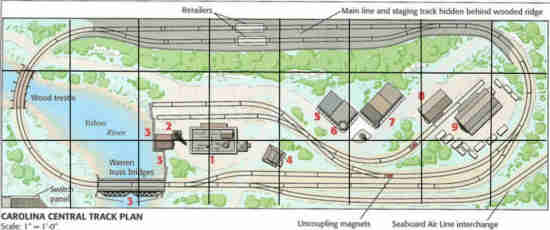Sometime You Get Your Best Layout
By Blowing It Up And Starting Over
When you have a spatial problem like translating a model railroad track plan from a magazine into a full blown, accurate layout, sometimes all it takes is a little time for quietly thinking about the solution.
While I was in ICU earlier this month I had the time and the nurses definitely wanted me to be quiet.
Got a Model Railroading Question?
Due to my space requirements in out apartment (I have been relegated to the spare room for my office, my closet and my hobby area) I was looking at room for a door and foam layout and I decided on modification of the Carolina Central in N Scale.
There is a beautiful rendition of this plan and a two chapter How to in the back of “N Scale Model Railroading” by Marty McGuirk.
Here’s what it looks like:

So how to get from this picture to a 30” by 80” and do it with accuracy, I wanted to get as much storage and switching room as possible.
While I was in the hospital, my wife brought in a picture she had blown up at Kinko’s (excuse me FedEx Kinkos, now FedEx Office) from a 3X5 to an 18 X 30. So just how big can this go?
What if I blew up the magazine rendition by scanning it into my computer and resizing it in Corel’s Paint Shop so it just fits the width of an 8.5 X 11 inch piece of paper. I settled on 8 inches and divided it equally into an 8X3 grid.
I use a program called SnagIt which allows me to capture sections of the plan and edit them. I selected grid borders two wide by three deep. In the SnagIt Editor, I resized the 2X3 sections to the width of the page.
I took the four pages to Kinkos where they used a plotter/printer to enlarge the three-section width to 30 inches, the width of my layout base. The other three sections were re-sized accordingly.
The next step is to glue the sheets (in order) to the foam core base using PVA adhesive which is particularly useful to modelers because it dries clear, can be thinned with water, and does not attack polystyrene foam. I try to keep the glue confined to an area directly under the track path applying it with a narrow spatula. Once the sheets are all tight, weight them overnight with the door.
Next day use an Xacto knife and cut away all but the track path. This will serve as the guide for laying the cork roadbed which will support the track, switches and eventually the ballast.


